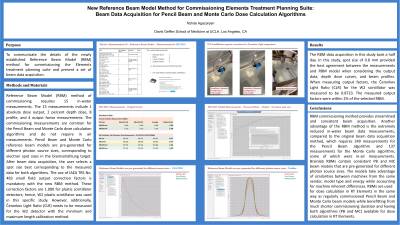Back

Objectives: : To communicate the details of the newly established Reference Beam Model (RBM) method for commissioning the Elements treatment planning suite and present a complete set of beam data acquisition.
Methods: : Reference Beam Model (RBM) method of commissioning requires 15 in-water measurements. The 15 measurements include 1 absolute dose output, 2 percent depth dose, 8 profile, and 4 output factor measurements. The commissioning measurements are common for the Pencil Beam and Monte Carlo dose calculation algorithms and do not require in air measurements. Pencil Beam and Monte Carlo reference beam models are pre-generated for different photon source sizes, corresponding to electron spot sizes in the bremsstrahlung target. After beam data acquisition, the user selects a spot size best corresponding to the measured data for both algorithms. The use of IAEA TRS No. 483 small field output correction factors is mandatory with the new RBM method. These correction factors are 1.000 for plastic scintillator detectors; hence, W2 plastic scintillator was used in this specific study. However, additionally, Čerenkov Light Ratio (CLR) needs to be measured for the W2 detector with the minimum and maximum length calibration method.
Results: : The RBM data acquisition in this study took a half day. In this study, spot size of 0.8 mm provided the best agreement between the measurements and RBM model when considering the output data, depth dose curves, and beam profiles. When measuring output factors, the Čerenkov Light Ratio (CLR) for the W2 scintillator was measured to be 0.8723. The measured output factors were within 2% of the selected RBM.
Conclusion(s):: RBM commissioning method provides streamlined and consistent beam acquisition. Another advantage of the RBM method is the extremely reduced in-water beam data measurements, compared to the original beam data acquisition method, which requires 249 measurements for the Pencil Beam algorithm and 137 measurements for the Monte Carlo algorithm, some of which were in-air measurements. The complete clinical validation of the RBM is the next step in the process.
Physics
WILD, WILD, WEST EVENING RECEPTION: Poster Presentations and Recognition
New Reference Beam Model Method for Commissioning Elements Treatment Planning Suite: Beam Data Acquisition for Pencil Beam and Monte Carlo Dose Calculation Algorithms
Thursday, March 20, 2025
5:20 PM – 5:30 PM MST
Location: Canyon I - IV


Nzhde Agazaryan, PhD, DABR, FAAPM
Professor and Chief of Clinical Physics
UCLA
Poster Presenter(s)
Objectives: : To communicate the details of the newly established Reference Beam Model (RBM) method for commissioning the Elements treatment planning suite and present a complete set of beam data acquisition.
Methods: : Reference Beam Model (RBM) method of commissioning requires 15 in-water measurements. The 15 measurements include 1 absolute dose output, 2 percent depth dose, 8 profile, and 4 output factor measurements. The commissioning measurements are common for the Pencil Beam and Monte Carlo dose calculation algorithms and do not require in air measurements. Pencil Beam and Monte Carlo reference beam models are pre-generated for different photon source sizes, corresponding to electron spot sizes in the bremsstrahlung target. After beam data acquisition, the user selects a spot size best corresponding to the measured data for both algorithms. The use of IAEA TRS No. 483 small field output correction factors is mandatory with the new RBM method. These correction factors are 1.000 for plastic scintillator detectors; hence, W2 plastic scintillator was used in this specific study. However, additionally, Čerenkov Light Ratio (CLR) needs to be measured for the W2 detector with the minimum and maximum length calibration method.
Results: : The RBM data acquisition in this study took a half day. In this study, spot size of 0.8 mm provided the best agreement between the measurements and RBM model when considering the output data, depth dose curves, and beam profiles. When measuring output factors, the Čerenkov Light Ratio (CLR) for the W2 scintillator was measured to be 0.8723. The measured output factors were within 2% of the selected RBM.
Conclusion(s):: RBM commissioning method provides streamlined and consistent beam acquisition. Another advantage of the RBM method is the extremely reduced in-water beam data measurements, compared to the original beam data acquisition method, which requires 249 measurements for the Pencil Beam algorithm and 137 measurements for the Monte Carlo algorithm, some of which were in-air measurements. The complete clinical validation of the RBM is the next step in the process.
